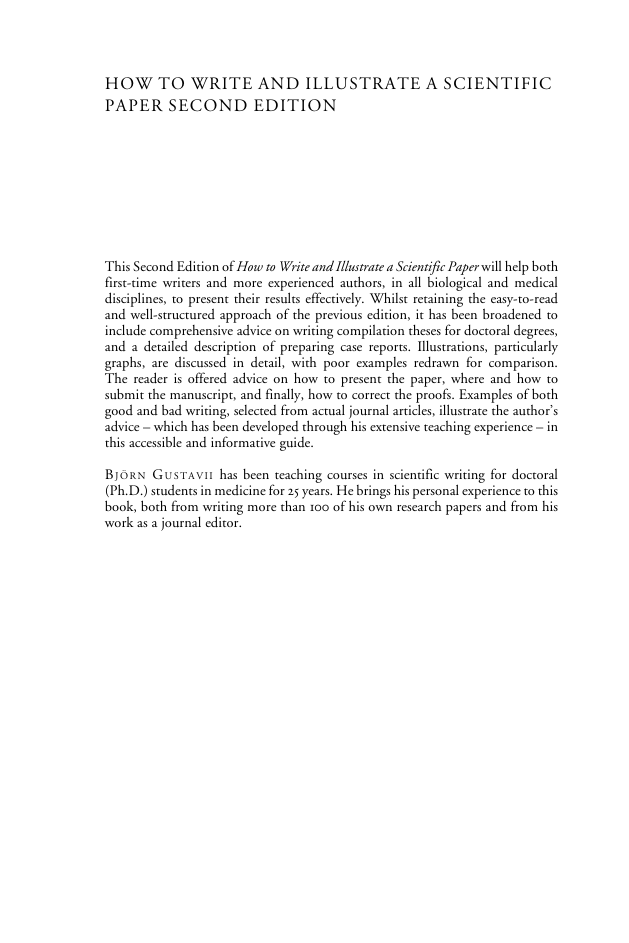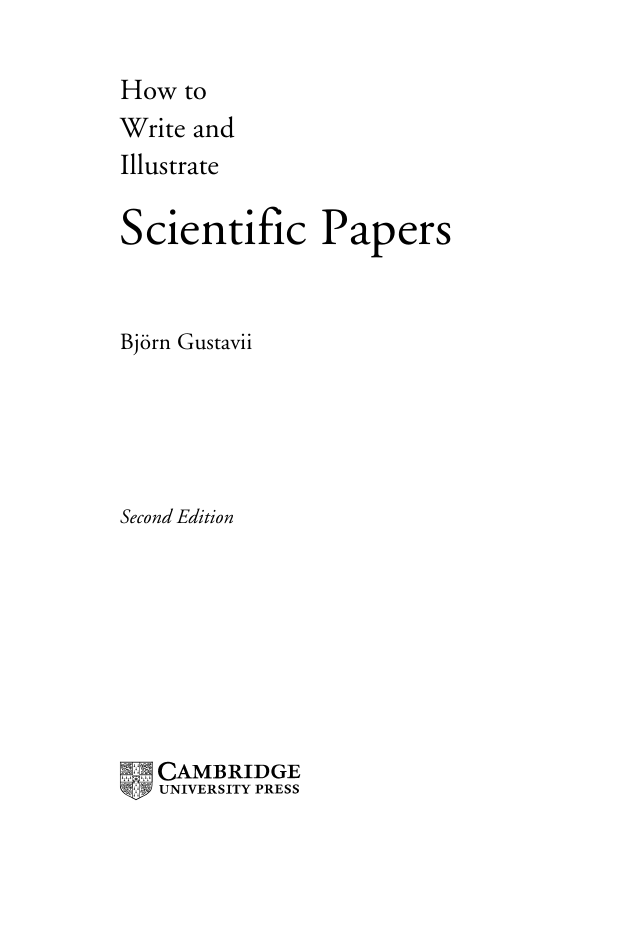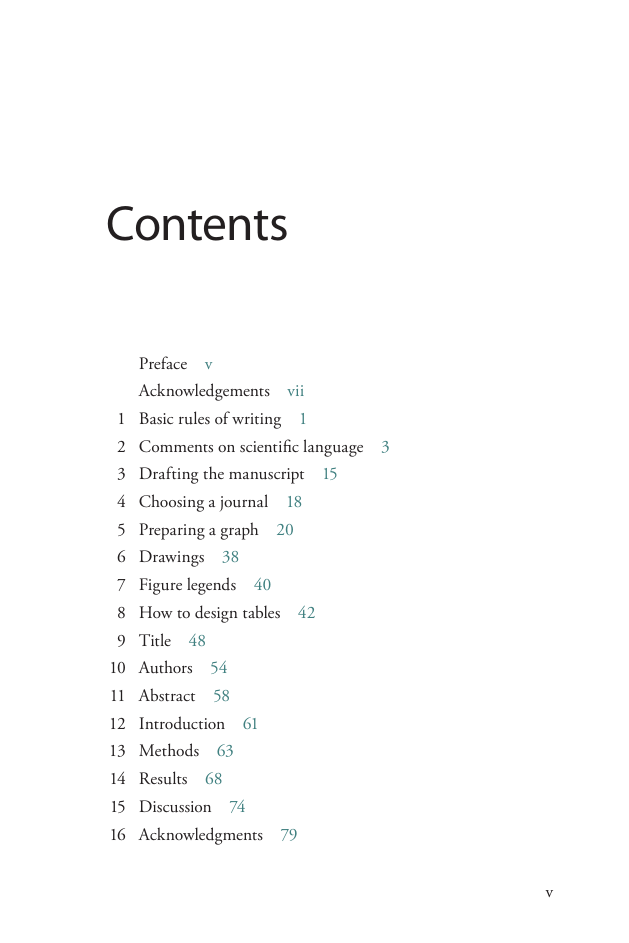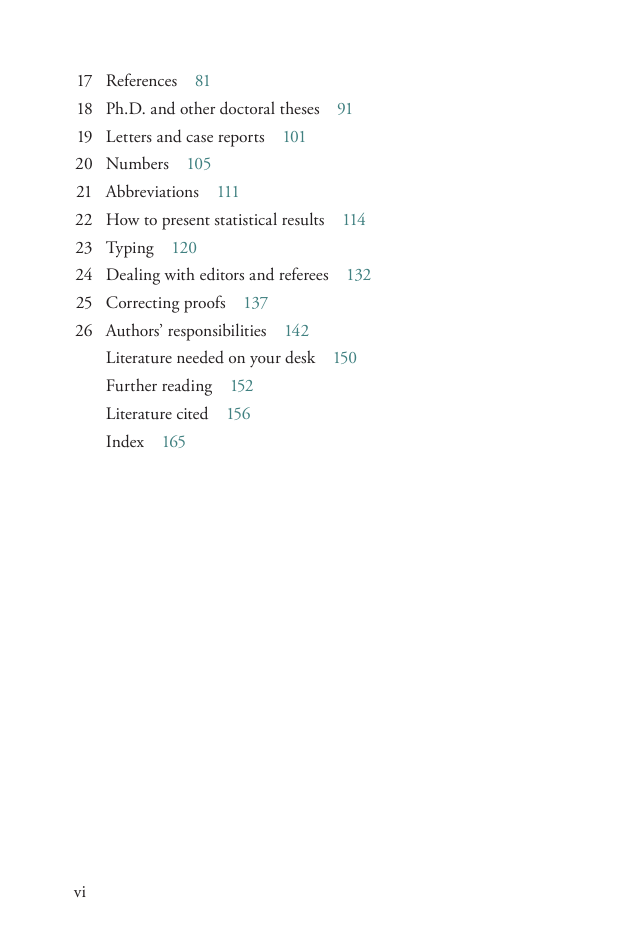Cover
Half-title
Title
Copyright
Contents
Preface
Acknowledgments
1 Basic rules of writing
Brevity
Logic and clarity
Clean typing
2 Comments on scientific language
English as a foreign language
Follow the “leitmotif”
Verbosity
He/she
Active or passive voice
Tense
Noun clusters and modifiers
Prevalence and incidence
Avoid the use of “respectively”
The “and/or” construction
Unnecessary hedging
How old is young?
Avoid synonyms to achieve elegant variation
The remote verb
3 Drafting the manuscript
Write down your thoughts as they arise
Where and when to write?
How it can work in practice
The other way around
Handwriting or word processing?
4 Choosing a journal
Instructions to authors
5 Preparing a graph
The line graph
Relationship between the lengths of the axes
Labeling axes
The chart
Before submission
6 Drawings
7 Figure legends
8 How to design tables
The descriptive title
The declarative title
Rounding off
Table or graph?
Typing the table
9 Title
Whenever possible, use a declarative rather than a neutral title
Titles ending with a question mark
Begin with the keywords
Use verbs instead of abstract nouns
Avoid abbreviations in the title
A title for your thesis
Running title
10 Authors
Guidelines on authorship
The contributors list
A question of coauthorship
11 Abstract
The conventional abstract
The structured abstract
12 Introduction
13 Methods
The subjects
Informed consent
Omissions in reporting of randomized controlled trials
Randomization
Blinding
Number of subjects
A checklist
14 Results
Participant flow and follow-up
Dropouts
Loss of participants to follow-up
Details of randomized participants
Study outcome
15 Discussion
Evaluate the results – not the authors
Avoid claiming priority
The reference-13 trick
16 Acknowledgments
Always give credit for financial support
17 References
Vancouver versus Harvard style?
The Vancouver system – also called the numbering system
The Harvard system – also called the name-and-year system
Accuracy of references and quotations
Your own author name
Chinese names
Anonymous
Record titles in the language of publication
Names of journals
How to refer to World Wide Web
18 Ph.D. and other doctoral theses
Compilations: the theses of the future
Contributors
Thesis at a glance
General introduction
Aims
Methods and results
General discussion
Acknowledgments
Cover illustration
A fresh look
The structure of the thesis overview
19 Letters and case reports
The thalidomide letter
Format and size of a letter
Transforming a paper into a letter
Case reports
Format and size of case reports
20 Numbers
Two numbers side by side
Decimal point
Thousands
Numbers with several zeros
Quotients of units
Percentages
Rounding to two significant digits
Enumeration
What do we mean by “often”?
21 Abbreviations
Units of measure
General principles
22 How to present statistical results
Using mean when median is meant
Using standard error instead of standard deviation
Failure to distinguish between statistical significance and biological importance
Selected presentation of multiple statistical testing
Overinterpretation of subgroup effects
Using relative instead of absolute figures
Some further comments
The ± sign
P < 0.05 = the truth
23 Typing
“Twain spacing”
12-point Times
Avoid using block capitals
Up-and-down-style versus down style
Do not mimic the journal’s style
The length of the manuscript
The importance of punctuation
24 Dealing with editors and referees
Do referees delay?
Unpublished work
Shortening the manuscript
Accepted or rejected
25 Correcting proofs
How to read proof
What to correct
Correction marks
Electronic proof
26 Authors’ responsibilities
Subjects’ right to privacy
Duplicate submission
Borrowing published material
Saving your original data
Literature needed on your desk
On phraseology
On synonyms
On manuscript preparation
On how to abbreviate a journal’s title
Further reading
Guides to writing
Punctuation
The English language
Style manuals
Illustrations
Statistics
Literature cited
Index
















 2023年江西萍乡中考道德与法治真题及答案.doc
2023年江西萍乡中考道德与法治真题及答案.doc 2012年重庆南川中考生物真题及答案.doc
2012年重庆南川中考生物真题及答案.doc 2013年江西师范大学地理学综合及文艺理论基础考研真题.doc
2013年江西师范大学地理学综合及文艺理论基础考研真题.doc 2020年四川甘孜小升初语文真题及答案I卷.doc
2020年四川甘孜小升初语文真题及答案I卷.doc 2020年注册岩土工程师专业基础考试真题及答案.doc
2020年注册岩土工程师专业基础考试真题及答案.doc 2023-2024学年福建省厦门市九年级上学期数学月考试题及答案.doc
2023-2024学年福建省厦门市九年级上学期数学月考试题及答案.doc 2021-2022学年辽宁省沈阳市大东区九年级上学期语文期末试题及答案.doc
2021-2022学年辽宁省沈阳市大东区九年级上学期语文期末试题及答案.doc 2022-2023学年北京东城区初三第一学期物理期末试卷及答案.doc
2022-2023学年北京东城区初三第一学期物理期末试卷及答案.doc 2018上半年江西教师资格初中地理学科知识与教学能力真题及答案.doc
2018上半年江西教师资格初中地理学科知识与教学能力真题及答案.doc 2012年河北国家公务员申论考试真题及答案-省级.doc
2012年河北国家公务员申论考试真题及答案-省级.doc 2020-2021学年江苏省扬州市江都区邵樊片九年级上学期数学第一次质量检测试题及答案.doc
2020-2021学年江苏省扬州市江都区邵樊片九年级上学期数学第一次质量检测试题及答案.doc 2022下半年黑龙江教师资格证中学综合素质真题及答案.doc
2022下半年黑龙江教师资格证中学综合素质真题及答案.doc